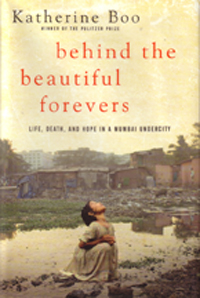If you were one of those people who said, “You know, I enjoyed Slumdog Millionaire, but it was just a little too upbeat,” I’ve got just the book for you. Behind the Beautiful Forevers: Life, Death, and Hope in a Mumbai Undercity is pretty much guaranteed to not only depress the hell out of you, but make you squirm with shame over whatever you were just complaining about. I thought I had it bad because my shower head likes to abruptly switch from cold to hot water… until I read about the Mumbai slum dwellers who have to wait in line for hours for the privilege of buying supposedly free city water from opportunistic poachers who lay claim to the public pumps. Hey, it’s better than venturing into the nearby sewage lake, filled with a chemical slurry that turns your skin blue.
Annawadi is a slum located next to the Mumbai airport, originally inhabited by the construction workers who helped to renovate and modernize the airport. Since then, successive groups of different castes have populated the settlement; now, it’s mainly occupied by garbage pickers. One such inhabitant is Abdul, a hardworking teenager who runs the family garbage-sorting business, buying bulk recyclables from individual garbage pickers and reselling larger volumes to the recycling plants. Their relatively successful business draws the envy of some neighbors, including a bitter, angry disabled woman called One Leg. Meanwhile, the local bigwig, Asha, is a woman determined to claw her way up to the middle class by gaining political power as a fixer in her district — delivering votes to the right candidates, extorting bribes and making payoffs to the right people, and all the other unsavory ways of getting things done in India’s infamously corrupt bureaucracy. Asha’s college-student daughter, Manju, is her favorite child and, she hopes, the family’s golden ticket into a more stable and prosperous life.
When Abdul’s family undertakes a home improvement project, the rotting shared wall between them and One Leg crumbles, sparking a loud street argument between the families. Later, still spluttering with rage, One Leg douses herself in kerosene and sets herself on fire, intending to cause minor injuries and blame Abdul’s family. Instead, the fire roars out of control, burning her so severely that she dies soon afterward in a shockingly filthy Mumbai hospital — but not before she has lied to a corrupt police official about Abdul’s family setting her on fire. Suddenly, the system grinds to life: the police arrest Abdul and his father, demanding bribes from their family for everything from meals for the prisoners to making the charges go away. Asha tries to grease the wheels, but Abdul’s mother indignantly refuses to pay the bribe, a disastrous error. Soon, extortionate demands from the police pile up, while One Leg’s widowed husband swears vengeance, and the tragedy splits the Annawadi slum into bitterly divided factions. And in the city outside the slum — a world that the Annawadians are barely aware of — Asha’s political patron is facing corruption charges of his own, the fallout of which may permanently spike Asha’s dreams of power.
Modern-day Mumbai sounds downright Dickensian in its corrupt, venal, industrial-age, environment-blasting bleakness, so it’s pretty inspiring that the quick-witted, inventive, cynically optimistic Annawadians are working so hard to improve their lives, even by small steps. But make no mistake: this is a grueling, relentlessly grim journey through unimaginably stark conditions, not some candy-colored Bollywood tale of romance and redemption. From the amoral greed of the police system to the callousness of local politics and the shockingly out-of-date healthcare system, it’s clear why it’s so hard for even the most entrepreneurial soul to get ahead. Nor are the Annawadians idealized as saintly, downtrodden martyrs: embodying the spirit of the times, they’re selfish, opportunistic, and greedy too, falling into backbiting and petty revenge when solidarity and pulling together would accomplish much more. In other words, they’re real people, and Boo brings them vibrantly to life with clear-eyed, matter-of-fact reporting. The narrative is assembled from Boo’s three years among the Annawadians, and while she does take some liberties in imagining the internal monologues and mental states of her subjects, she does so in a way that’s true to the spirit of the story and to what we know of their characters.
If all this sounds like the literary equivalent of a root canal, well, let me urge you to give it a chance. The story is eye-opening and brutally honest without being exploitative or schmaltzy; Boo gives her subjects the dignity of presenting their stories straightforwardly and letting the tale tell itself. It’s agonizingly suspenseful watching this hapless family pit their few resources against the machine of society, and while you may find yourself disliking them and their actions at times, that won’t stop you from rooting for things to improve for the Annawadians. And although Boo doesn’t go this far, it’s impossible not to take a step back and wonder how complicit we first-world consumers are in creating this nightmare: after all, it’s our tourism dollars pumping into that shiny new airport that created the slum, it’s our e-garbage and chemical waste that gets dumped into their landfills, and our unwanted electronics that the garbage pickers tear apart and sort through for bits of metal and wire to resell.
So yes, this book is a major downer, but only because it tells it like it us for people who aren’t nearly as privileged as we are. I’m thinking about keeping a hardcover copy around so someone can smash me over the head with it every time I complain about how long Facebook takes to load on my smartphone.
- Spring 2020 Book Preview - May 15, 2020
- Winter 2020 Book Preview - January 1, 2020
- Fall 2019 Book Preview - September 26, 2019



Leave A Comment